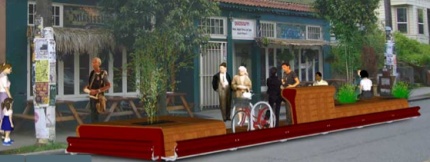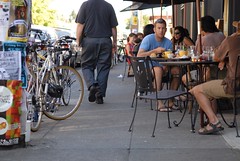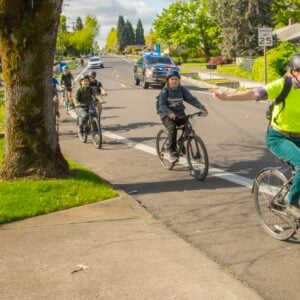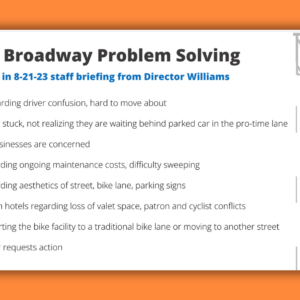
(Illustration by Joshua Cohen/Fat Pencil Studio)
When San Francisco debuted their “sidewalk extensions” back in February, they made quite an impression here in Portland. Local environmental scientist Rebecca Hamilton was so inspired by the idea she threw herself head-first into bringing one to Portland.
Hamilton is behind Re-thinking the Right of Way (RetROW), a grassroots group hoping to install “ped plazas” in Portland. The mini plazas would transform 1-2 on-street parking spaces into benches, planters, and maybe even a bit of bike parking. Hamilton sees the plazas as a way to make streets more human-scale:
“We’ve got some avenues that are very pedestrian intensive… but you can see there’s a greater need for people in those spaces than there is for on-street parking. It might be time to think of re-purposing that space for people instead of private storage space. It’s also a great way to build community and strengthen the neighborhood.”

(Photo: RebarGroup.org)
After New York City unveiled their version of the “sidewalk extension” (which they dubbed a “pop-up cafe”) last week, I checked in on how Hamilton’s efforts are coming along.
Hamilton and her partner on the project, designer and illustrator Joshua Cohen of Fat Pencil Studio, met with PBOT back in March and have nothing but praise for how supportive the City has been. PBOT staff have suggested possible locations, advised them on engineering and liability issues, and connected them with potentially supportive businesses. In May, RetROW applied for a Community Livability Grant through the Portland Development Commission and PBOT wrote a letter of support for their application. The letter, signed by PBOT Director Sue Keil, stated:
“This project offers an innovative and low cost approach to improve the pedestrian environment and enhance community vibrancy in Portland’s neighborhood commercial centers.”
Unfortunately they didn’t get the grant, but that hasn’t stopped Hamilton from trying to move the idea forward.
“We want to put some cool things out there to get people tugging at PBOT’s pant legs and saying ‘Hey, we want these!'”
— Rebecca Hamilton, RetROW
While Hamilton maintains, “We have a good relationship with the city” she also acknowledges that there are some “major issues to work out before they’re willing to put something on the streets.” Liability is a big one. The City has to be sure who’s responsible for the structure (them or the adjacent business owner). There’s also the permitting process, which includes a design and engineering review; support from local neighborhoods and businesses; a maintenance agreement; and a repair budget and contingency plan in case the structure is damaged.
New York City’s pop-up cafe reportedly took just 35 days from idea to installation. Hamilton says she’s also learned that New York City flew out a designer from San Francisco’s Pavement to Parks program to kick-start their project. That’s a sign, Hamilton says, “That means those cities are actively trying to incorporate this sort of space into their environment.”

of sense on Alberta Street, where
crowded sidewalks are common.
(Photo © J. Maus)
I asked Hamilton why she thinks PBOT, who has known and supported the idea since March, hasn’t made it happen yet. She says it feels “Like something that we’re trying to push from the ground up. It doesn’t seem yet that there’s a big enough demand from the people for them [PBOT] to start working top down and investing their time and resources on this project.”
Hamilton said New York City and San Francisco both already have city-sponsored programs specifically to re-purpose street space to create more public plazas; the New York City Public Plaza Program and Pavement to Parks respectively. Both cities also have planning documents in place that support the plazas.
“Without a government mandate,” Hamilton says, “and with no dedicated financial or personnel resources within the City to pursue this, much of the leg work and funding for Ped Plazas is up to the people that want them.”
Hamilton’s hope is to get one of the ped plazas installed as a pilot. Right now, she thinks it would be easier to buy an existing structure from San Francisco-based Rebar Group, who has already made and tested the design. The price to get it to Portland is $15,000 (once the first one is installed, then they’d create a Portland-made version).
RetROW is now focusing their efforts on doing more community outreach. Their big target is Park(ing) Day which is September 17th. Hamilton says they’re also looking for business owners who might be interested in hosting a “one-day parklet” in front of their shop. And of course they need more community support. “We want to put some cool things out there to get people tugging at PBOT’s pant legs and saying ‘Hey, we want these!'”
To learn more, visit RetROW.org or email Rebecca Hamilton at rebecca[dot]hamilton[at]retrow[dot]org.






Thanks for reading.
BikePortland has served this community with independent community journalism since 2005. We rely on subscriptions from readers like you to survive. Your financial support is vital in keeping this valuable resource alive and well.
Please subscribe today to strengthen and expand our work.
Where do I sign?
Meh.
Want a real impact? Closed an entire block or two where restaurants and small shops are clustered. A real pedestrian plaza. Better for traffic calming and livability.
All this does is eliminate two parking spots and put those using it closer to vehicle noise and exhaust.
I’m sorta with Brad, only I see it from a different angle. Clever craftsmen build something nice, then no one maintains it until it looks like crap, then it gets torn down and declared a failure.
We get all giddy about the new shiny thing, then move on to the next one. How about putting the shine (smooth, strong, bright or functional) back onto some of our existing streetscape?
These things are common in Europe and parts of Canada. You can sit there and have nice folks bring you food and drinks for a little cash. Instead of tax and spend, why not provide jobs and a source of revenue?
For three months out of the year. When the rains fall, these will largely sit vacant, neglected, and will be excellent for tagging.
Think big! For example, the two blocks of Alberta where all the eateries, shops, and CCC are located should be shut to auto traffic and transformed into a European styled plaza. I believe this would create a living room for the neighborhood and provide much more traffic and commerce than one or two of these little islands.
For the past few years on Belmont, we have been setting up greenspace for PARKing Day; using leftover sod from the Belmont Street Fair [Sept. 12th].
This is at 33rd/34th, between the bike corrals, and in front of Laughing Planet.
They are always very supportive, so I would encourage Rebecca to get in touch with me, and see if we can arrange for a “ped plaza” this year. This neighborhood would be ALL OVER THAT.
I bet we could put our minds together and come up with a modular design for ease of set-up/take-down. In this city, which seems to have gotten bogged down in the streetscape-innovation-mud, we will have to be patient on permanent installations.
I have to agree with Brad. Create pedestrian-only spaces of several blocks like so many cities in Europe have. But, I’d take it one step further – cover those spaces so they can be used year ’round in Portland’s wet climate. Now they become revenue sources (and outdoor spaces) 12 months a year instead of only three.
Alberta definitely needs some kind of treatment, but one that integrates a broader set of concerns. Convert any part of it to a no-cars ped plaza, and the value of the Going bike boulevard is going, going, gone.
A bigger picture plan that I would like to see is diverting ALL of NE Alberta’s arterial traffic a couple blocks north to Killingsworth, which is a ten-times-better car thoroughfare and is underused. THEN convert key patches of Alberta to (partially covered) ped plazas with a cycle track running down the middle.
I think mini ped plazas/sidewalk extensions, like the ones in this story, are a *perfect* solution for demonstrating the value of converting street space to people space, ultimately as I’ve envisioned above.
I think you have to use quick and easy–but highly visible–demonstration projects like these in order for a bigger audience to catch the vision of something transformative.
Streetfilms did a neat film that shows how the structures work.
Wayne and Brad: I like your ideas as an ultimate goal, but your argument sounds like my daughter pitching a trip to Disneyland, when all I suggested was going to the park after school. Disneyland might be great when a vacation is on the table, but it doesn’t mean a trip to the park is a bad idea now.
Great idea on the covered plaza, Wayne. I think that’s critical for winter use, regardless the size of the plaza.
yes, having an area where several blocks were closed to automobiles and converted into a real pedestrian plaza would be fantastic. why not think of this as planting the seed towards the larger change? the extra space in these congested areas has the potential to benefit many more people than the 2 drivers who will lose a convenient parking spot.
macchu picchu–
exactly what i was thinking, but more interestingly phrased. this is what i get for taking too long to think about my response before submitting. baby steps can make the major changes happen. don’t shoot down the process before it starts.
Just to clarify – the plazas would be semi-permanent features that sit on top of the pavement. They can be moved (or removed) based as conditions dictate – for street maintenance, for example, or if the local business supporter decides that the space is more valuable as parking during the rainy winter months.
The flexibility of the design is key – we should be able to re-evaluate the use of public space from time to time.
Also – a maintenance agreement for the structures with the nearby supporting business(es) would be required by the City, similar to how the on-street Bike Corral program works. We want to keep our public spaces inviting and comfortable.
Thanks! – R
Transforming parking spaces into “ped plazas” is a feasible idea that can get the ball rolling for “bigger visions.” Closing entire streets isn’t going to be practical everywhere, however conveting a parking space into a miniature park could be done almost anywhere. Let’s use some parking spaces as a canvas for creatively designed public space!! What a beautiful idea.
I still think Ankeny Alley is a great opportunity for peds in PDX. Here’s a PP from a presentation I did for the Traffic and Transportation class at PSU in 2007. http://bit.ly/dnaB0e
I spent some time in San Francisco at Mojos; a cafe/bikeshop with one of these plazas in front of it.
I knew the area well before it was installed.
The difference is HUGE. The feel of the immediate neighborhood is much friendlier. It was a place to get thru on the way to somewhere else, and now it’s a place people like to hang out in. That Portland hasn’t tried these yet is rather odd .
Thanks for your work on this Rebecca.
but this would take away BMW parking!
It seems like restaurants adjacent to these islands should be clamoring to have them installed, and happy to pay the full cost, not simply maintenance. The resulting increased business should be more than adequate.
In return, the City allows the business to take up limited public space for private enterprise – but we all benefit from safer and more pleasant conditions.
I think this is a great idea. Brad’s concerns that they would go unused is unfounded. Obviously the structures would have to be weatherproof and provide shelter from Portland’s rain.
What an amazing idea! This is a perfect place to stop on the sidewalk for a few minutes or an hour, maybe to read a text or reorganize your thoughts. I love it, and I also see it as a step towards more pedestrian-friendly developments.
The metaphor of Disneyland vs. the park is perfect.
Personally, I don’t know why anyone would be more worried about these getting tagged than anything else in a city. Although I hate graffiti, that shouldn’t be a stumbling block to getting these on the streets. Maybe they could be pre-tagged artistically…? So follow-up tagging wouldn’t show up as well?
Way to go Rebecca and RetROW! I’m excited to hear the conversations have already started. This sort of road space reclamation is way overdue in our city. Once again, we see that this sort of change rarely comes unless we ask for it. Looking forward to demonstrating public support for these projects together!
In NYC I’ll say that additions like this to the street add only positives to the experience of navigating around the city. I definitely understand the people wanting to completely revamp whole blocks immediately, but these structures seem like well-designed and pitch perfect beginnings. Congratulations Ms. Hamilton and Mr. Cohen and good luck moving forward!
any way to beautify the city, i am in favor. i applaud your efforts rebecca. good luck and i support you.
Awesome idea! I hope to see it happen and I wish you the best with the project.
Portland has no idea how to make a city “ped” friendly. The urban growth boundary set of priorities is skewed. They tax and tax and spew out a green bike box as a token and you suckers eat it up. What good little Statist lemmings. You want to beautify the city? Plow down all of Hawthorne.
“Green”… the other Communist pink.
this idea is superb and a logical extension of various street upgrades in favor of people over cars.
I wish the city could work with its people a little faster for these sorts of demonstration projects. the implementation of a few would cost less than the series of meetings they will have to discuss it.
I love this concept! Having more space in front of local businesses for gathering and eating during the seasons when the demand is high, with the option of returning the space to parking in the rainy winter is a brilliant idea.
“any way to beautify the city, i am in favor.”
Beautifying the city while the number of homeless surges and thousands are without jobs is very low on my priority list. We need jobs not more trustafarian conceits.